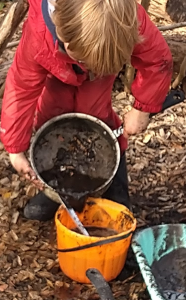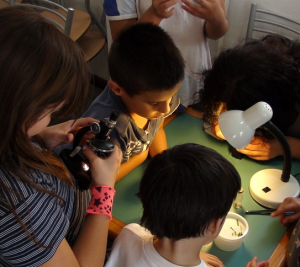by James Cairney
 I wish early years settings would engage more in STEM (science, technology, engineering, maths). Access to science play and experimentation is essential for our weans. Their thirst for knowledge is powerful. They like to know how things work and – like adult scientists – repeat tasks over and over until they find out.
I wish early years settings would engage more in STEM (science, technology, engineering, maths). Access to science play and experimentation is essential for our weans. Their thirst for knowledge is powerful. They like to know how things work and – like adult scientists – repeat tasks over and over until they find out.
The adults involved don’t have to have a science background. Enthusiasm is all that’s required – an enthusiastic grown-up supporting a child in exploration is worth a thousand ‘lessons’.
Little scientists
I watched my two-year-old granddaughter working out how the seatbelt in the car works. She tried it numerous times until she mastered it. Simple thing for an adult but the application and perseverance of the child was tremendous to watch.
My grandson, aged four, asked me three times to sing the words of a song so he could learn it. Took him two minutes to learn it word for word and recite it back to me. His quest for mastery was complete in two minutes. Brilliant examples of the abilities of our young children.
Most three- to seven-year-olds are like that – their curiosity is at the optimum stage of development. Little scientists from birth and eager to experiment! So why not engage them in science learning through fun and experiences?
Bringing STEM to early level
 Just as young children need a ‘literacy-rich environment’ to develop interest in reading and writing, they need a ‘science-rich environment’ to develop interest in science… and in the words of a recent report, ‘scientific literacy is critically important to being an informed citizen.’1
Just as young children need a ‘literacy-rich environment’ to develop interest in reading and writing, they need a ‘science-rich environment’ to develop interest in science… and in the words of a recent report, ‘scientific literacy is critically important to being an informed citizen.’1
We ought to have a STEM link from early years setting to primary to secondary school to further education. Established, embedded in the curriculum for all – and the starting point for future scientists, engineers, teachers, and many more jobs of the future, whatever they are…
I know some councils – including the one I work for – have already implemented this process. Every council should endeavour to do likewise. However, it only works if all concerned are prepared to invest time and effort in keeping the link active and present. A rolling programme every year to keep it progressing.
On numerous STEM evenings or young workforce days, I’ve heard parents ask: ‘Can my child do science?’ My, what a question! Science is for everyone – it is all around us. It has nothing to do with some sort of ‘ability’. Curiosity and enthusiasm are all that’s required
What would early level STEM look like?
 So, what kind of things can children do? Well, they already build things. They already play with water. They’re usually fascinated by nature, habitats, birds, animals. Outdoor play and learning is very much to the fore and an essential part of learning for our young people. So it’s all there for the enthusiasm to take root. You’ll find plenty of resources and guidance in books, media and local schools to allow learning to flourish.
So, what kind of things can children do? Well, they already build things. They already play with water. They’re usually fascinated by nature, habitats, birds, animals. Outdoor play and learning is very much to the fore and an essential part of learning for our young people. So it’s all there for the enthusiasm to take root. You’ll find plenty of resources and guidance in books, media and local schools to allow learning to flourish.
Scotland’s national STEM programme resources currently seem to start from primary school age. I’m sure that it could be extended to incorporate the whole of CfE’s early level. More often than not, advice and guidance is all that’s required to help practitioners support children’s scientific explorations and experiments.
What if we could produce STEM kits for early level, with ideas and information? Ideas like ‘kitchen chemistry’, using baking soda and vinegar, or raisins and lemonade (see the end of this blog for a few examples). Child-friendly apparatus, and tips for the adult helpers on scientific language and terminology the children can use in their play… Lab coats and goggles in the dressing up area….
Schools could also provide training in health and safety aspects and risk assessment when attempting experiments. What about bringing the children on visits to the local secondary school to see the lab environment? Maybe involving S6 students as STEM ambassadors delivering simple experiments in early years settings?
The STEM gap
 Why should our little ones have to wait until primary school for science? Science is about trying things, seeing what works and what doesn’t … young children’s curiosity cries out for science!
Why should our little ones have to wait until primary school for science? Science is about trying things, seeing what works and what doesn’t … young children’s curiosity cries out for science!
And yet, we have an attainment gap in science just as big as that in literacy and maths. If scientific enquiry comes naturally to children, how can that be? Science education is one of the keys to social mobility. Science qualifications open the doors to many rewarding and interesting careers. It’s our duty to ensure that every child has a chance to pursue a career in science.
STEM subjects are the key for our children at the youngest stage possible to grow their minds and secure their future. From the cradle to university their lives are in our hands so we need to nurture their skills and curiosity to the full, right from the start. Full STEM ahead!
James Cairney is a Senior Technician in a secondary school and a STEM Ambassador (yenriacsemaj@yahoo.co.uk)
Ref 1. Sir John Holman ‘Improving Secondary Education’( The Gatsby Foundation)
FOUR EXPERIMENTS WITH EVERYDAY INGREDIENTS
The Walking Water Experiment
You need: two identical glasses, water
- Set your two identical glasses about 2 inches apart. Pour water into one of the glasses until it’s halfway full.
- Add a few drops of your favourite food colouring to the water.
- Stir the food colouring until the water is one colour.
- Take a strip of paper towel and fold it until it’s 1 to 2 inches wide.
- Place one end of the paper towel strip into the coloured water and the other end into the empty glass. Let them sit for one hour.
- Return to the glass and observe what happened.
Spoiler alert: you will find that half of the coloured water travelled to the other side of the glass! The paper towel will also be the same colour as the water you started with.
What’s the science?
The water appears to defy gravity because of a process called capillary action. Water molecules stick to each other and they stick to the fibres of a paper towel. The adhesive forces between water molecules and the fibres of the paper towel are stronger than the cohesive forces between the water molecules in the glass.
Water molecules are therefore attracted to the fibres, pulling other water molecules with them. As a result, the water travels up and across the paper towel out of one glass and into another.
Capillary action is the combined force of attraction among water molecules and the molecules of surrounding materials.
The Dancing Raisins Experiment
You need: some fizzy lemonade, raisins, a glass tumbler.
- Pour the lemonade into the glass until it is about 3/4 full.
- Next, take a handful of raisins (approximately 10-15) and carefully place them into the glass. Then take a step back and watch.
- What initially happened to the raisins? Did they sink to the bottom? Did they float to the top?
What’s the science?
We’d expect the raisins to sink to the bottom because they are solid objects. But once they are immersed in the lemonade, they start to absorb it. Lemonade contains a gas (carbon dioxide), which is what makes it fizzy. As the raisins absorb the carbon dioxide, it lifts them up and propels them about in the liquid as though they were dancing.
The Bubble Bomb Experiment
You need: water, baking powder, vinegar, measuring cup, zipper-lock plastic sandwich bags, paper towel, tablespoon.
- Best to do this outside because it makes a mess.
- Make sure the plastic bag doesn’t have any holes. Put about half a cup of water
 in it, zip it locked and turn it upside down to check.
in it, zip it locked and turn it upside down to check. - Tear a paper towel into a square about 5 inches by 5 inches. Put 1½ tablespoons of baking powder in the middle of the square. Then fold it as shown in the picture, with the baking powder inside. This is your ‘time-release package’.
- Open the plastic bag and pour in ½ a cup of vinegar and ¼ cup of warm water.
- Next comes the tricky part. You have to drop the time release package into the vinegar mixture and zip the bag before the fizzing gets out of control. Try zipping the bag half closed, stuffing the package in and zipping it up very quickly.
- Shake the bag a little, then put it on the ground and stand well back.
- The bag will puff up dramatically, then explode!
What’s the science?
As your time release package sinks into the bag, the water/vinegar mixture seeps into it. The vinegar (an acid) then reacts with the baking soda (a base), creating a gas called carbon dioxide. This gas expands very rapidly, creating pressure inside the bag, making it puff up and eventually pop open to let the gas escape.
Fishing for ice
 You need: a bowl of water, ice cubes, piece of thread, salt
You need: a bowl of water, ice cubes, piece of thread, salt
Put the ice in the water and lay the thread across one of the cubes. Sprinkle salt over the thread, stand back and wait for a couple of minutes. Pick up the thread and see if it will bring a chunk of ice with it. Demonstration here (click the wee arrow in the top right-hand corner).
What’s the science?
When you add salt to water, it lowers the temperature. The water immediately around the ice cube freezes, trapping the thread into the cube so you can fish it out.


